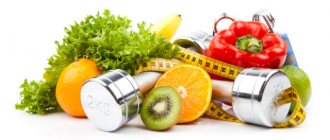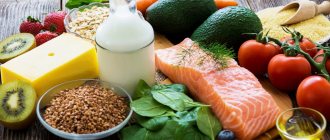Purpose of nutrition according to doshas
Ayurvedic teaching suggests that diseases begin with digestive disorders and it is better to prevent the development of pathologies at the beginning with the help of diet. Vata, kapha and pitta are in cyclical movement in the human body. At different times of the day, one of the doshas predominates over the other. Their balance determines the physical health of the human body. Doshas control metabolic processes:
- Pitta regulates the absorption and digestion of food.
- Kapha – promotes the creation of new and regeneration of damaged cells.
- Vata is responsible for the breakdown of molecules for the synthesis of substances necessary for the body.
Ayurvedic teaching divides food into 3 types:
- Activating Sattva (light, harmony) – light, sweet food that improves mood. It is worth eating before mental stress.
- Inducing Tamas (despondency, inertia) - warmed up yesterday's food, provoking apathy, laziness, slowdown of metabolic processes.
- Strengthening Rajas (energy, activity) - salty, spicy, sour foods that evoke a desire to act and determination.
Ayurveda believes that poor nutrition and failure to follow natural rhythms leads to illness. Following a diet according to body type helps cleanse the small and large intestines. This determines the health of soul and body. Diet recommendations for nutrition:
- Maintain 3-hour intervals between meals.
- Do not drink milk or water with meals.
- Eat only in a good mood, silently, chewing your food thoroughly.
- Eat only freshly prepared foods.
- Eat warm food.
- Eat only those foods that correspond to the structure of your body and coincide in rhythm with the season and weather.
The importance of proper nutrition
Food is an important part of the life of each of us. But we all evaluate it differently: for one, food is a great pleasure, for another, it is a common means of filling oneself with energy, for a third, it is a way to close anxiety or reward oneself. In Ayurveda, food is an offering to God. And God is perceived as a luminous fire inside our bodily shell.
Indian dish, Ayurvedic nutrition
As valuable as this offering will be, so will be the gift in return - bodily health and beauty.
Ayurveda believes that the Creator himself gives all living beings what is necessary and important to maintain vital energy. But when a person goes beyond the boundaries of harmonious existence in nature, he loses true connection. Simply put, he does not understand why he actually eats, and what food should be for him. Ayurveda is a source of knowledge about how to live in the physical body, what to eat and what to do. And if you gain this Ayurvedic knowledge for yourself, you will not only be able to lose weight, improve your nutrition, but you will do it harmoniously, correctly, not from the point of view of standards, but from the point of view of the characteristics of your body.
Features of vata pitta dosha
Biological doshas determine the type of build of a person’s body and his mentality. Depending on what predominates - vata or pitta (air or fire), the body and soul of a person are formed:
- vata – restlessness, fussiness, anxiety;
- pitta – impulsiveness, anger, short temper.
There are mixed constitutions with a predominance of one of the energies - vata pitta, vata kapha, pitta vata dosha. People of the Vata Pitta type have a slender body, closer to athletic, above average height, a cheerful temperament, and original thinking. They often apply it in life, achieving some success.
Air and Fire people love to eat well, especially sweet dishes. But you shouldn’t get carried away with large portions - this can cause problems with food absorption and bowel movements. An imbalance between the doshas reveals the negative sides of people of this type - hot temper, inconstancy, aggression. The situation can be corrected by following a diet.
Primary elements, doshas and gunas
The concept of Tridosha is the basis of Ayurvedic knowledge. She talks about the three components of the physical body: Vata (wind, air), Pitta (bile, fire), Kapha (mucus, earth). And these doshas are created by 5 primary elements: Ether , Air , Water , Earth , Fire . Everything in the Universe consists of these primary elements. And our body too.
The nature of air is lightness and mobility, the nature of ether is space, the nature of fire is heat, the nature of water is fluidity, and the nature of earth is hardness. Ether in the human body manifests itself in the mouth, nasopharynx and nostrils, chest, blood vessels, respiratory system, etc. Air reflects the variety of movement, fire is compared to metabolism (metabolism). Water is represented by liquids (saliva, plasma, gastric juice, etc.). Well, the Earth is everything solid in the human body, bones, nails, cartilage, hair, etc.
Each product is one of the 5 primary elements. Each element has its own type of energy and affects our body in a certain way.
| Primary element name | Characteristic | How balance manifests itself | How does excess manifest itself? | How does the deficiency manifest itself? |
| Ether | Porous, thin, cold, without a distinct taste. In the body, ether fills empty spaces. Vata dosha consists of Ether and Air, it is necessary to prevent the increase of Ether to avoid imbalance of the dosha. | If there is enough Ether in your body, it is in balance, you feel like a flexible person, adapting well to events and external changes, your body does not know problems with the intestines. Women have regular menstruation. | With an excess of Ether, a person experiences a feeling of detachment from real life. | If the etheric element is lacking, the person is stubborn and tense. It is necessary to increase the content of products with bitter taste in the diet, since it consists of Ether and Air. |
| Air | Cold, dry, light, bitter taste. Air is a force that helps blood circulate, helps move and breathe, think, and digest food. Vata dosha includes Air. The Air element is present in bitter, pungent and astringent tastes. | When this primary element is in balance, a person is motivated, enthusiastic, inspired, and incredibly productive. | With an excess of Air, a person becomes hypersensitive. The primary element can be brought into balance by including spicy, bitter, astringent foods in the diet. | If there is a deficiency, lethargy, slowness, and passivity occur. For balance, you need to significantly reduce your consumption of spicy, bitter and astringent foods. |
| Fire | It is a generator in the body, representing all the energy sources within it. Hot, dry, light, coarse, fine food. Pitta dosha consists of Fire and Water. Presents an oily, tangy taste. | You have a great capacity for love, compassion, know how to enjoy life, and are full of enthusiasm. You are generous and active, ready to change the world around you. You have no digestive problems. | Heat accumulates, redness and rashes appear on the skin. There is no peace of mind, no ability to concentrate. The person is irritable and angry. It is necessary to reduce the consumption of oily and spicy foods, as well as hot foods. | Eyes lose their shine, skin becomes dull, metabolism slows down, food is poorly digested. Digesting new information is also difficult. Laziness and passivity arise. Eat more hot, oily foods, add spice to your dishes. |
| Water | Liquid substance, cools, softens, moisturizes, lubricates. The Water element consists of sweet, salty and spicy. Kapha dosha consists of Earth and Water. Pitta dosha consists of Water and Fire. | The person copes well with stress, his physical shape is optimal, he is easy-going and active. | Digestion worsens, toxins are formed, swelling and obesity appear. Efficiency and motivation disappear. Eating dry and light foods, ginger and cloves will help you achieve balance. You need to give up sweets and an abundance of dairy foods. | Weight loss, constipation appears, and reproductive functions may deteriorate. Eating milk, ghee and sweet foods will help you achieve balance. |
| Earth | Heavy, rough, cold, dense, motionless. This element is identified with sweet taste, as well as sour and astringent. Kapha dosha consists of Earth and Water. | Self-confidence, good career growth, ability to communicate correctly and build relationships with different people. Purposefulness, accuracy, persuasiveness. | Excessive anxiety, stress over little things, lack of your own ideas, no reliance on your own opinion. Include ginger, cloves, fennel, and coriander in your food. | Bored, restless, exhausted, sad. Such a person’s digestion worsens. You need to add foods with “grounding” properties to your diet, such as root vegetables, oils and grains. |
Let's look at an example of how this knowledge about the primary elements is related to nutrition according to the doshas and Ayurvedic nutrition in general. For example, a person is diagnosed with digestive problems. Food is poorly digested, vitamins are not absorbed enough, a person gains excess weight and cannot get rid of it. If food with the primary elements of Earth and Water predominates in the diet (i.e. cold, heavy food), this extinguishes the Fire of nutrition. And a drink consumed after a meal will not give the fire a chance to flare up again.
Now about the doshas, the biological principles that control all processes in the body.
There are 3 doshas in our body:
- Cotton wool. Air and Ether. The constitution of people with a predominance of this type is as follows: lanky figure, thin bones, asthenic physique, thin limbs, dry skin, weak hair. It is localized in the lower part of the body (from the heels to the navel). Carries out motor processes and is responsible for inflating the digestive fire. Helps conception. Vata is associated with cold, dryness, lightness. If there is increased cold, a person will freeze all the time; if it is dry, his skin will crack; if there is increased lightness, he will lose weight. With a deficiency of this dosha, a person is overly relaxed and apathetic.
- Pitta. Water and fire. The constitution of people with a predominance of this type is as follows: athletic build, strength, normal weight, good gain of muscle mass. Provides metabolism, digestion of food, maintenance of body temperature and tissue transformation. An increase in this dosha is manifested by heartburn, nausea, and peptic ulcers. This is also manifested by inflammation and redness, rashes on the skin, and fever.
- Kapha. Earth and Water. The constitution of people with a predominance of this type is as follows: a harmonious, but inclined to be overweight physique. If the diet is incorrect, they will quickly gain weight. Forms the body and its mass, fixes fluid levels and lubrication of joints, organizes the interaction of organs. Does not allow the digestive fire to flare up too much. Excess kapha causes heaviness in the body, impaired mobility, slowness of activity, pallor, and sweating.
Every person has these 3 doshas in their body, but in different proportions. One may dominate, or two may be approximately equal. If the three doshas are in proportion, it is considered ideal.
Ayurvedic nutrition according to the doshas is also related to the topic of gunas. Guna in ancient teachings are types of influence on all material beings (the influence of the Creator’s energy).
Characteristics of the gunas and food associated with them:
- Sattva – balancing, filling force. This food is easy to digest and quickly nourishes the body. Products: fresh food, milk, homemade yogurt, ghee, peaches, mangoes, pomegranates, coconuts, lettuce, whole wheat, rice, beans, nuts. Spices: cumin, cinnamon, basil, fennel. Animal food is not included in this guna.
- Rajas is passion, activity, excitement. This food raises the heat content of the body. Products: oranges, bananas, apples, lemons, nightshades, peppers, cucumbers, potatoes, cauliflower, spinach, broccoli, grains, corn, buckwheat, beans, cheese and shelf-stable store-bought yogurts. This guna includes tea and coffee, white poultry meat, shrimp and almost all seasonings.
- Tamas – this guna is inhibitory and inactive, pulling a person down. Such products provoke heaviness in the body. Products: plums, avocado, watermelon, apricots, as well as mushrooms, pumpkin, brown rice, certain types of legumes, eggs, any meat (except white chicken), fish, shellfish. This includes deep-fried dishes, canned food, alcohol, and food that has been in the refrigerator for a long time.
Every phenomenon in our world has its own predominant guna.
The guna of food comes with it into our body, becoming the guna of our state. Another name for gunas is mental doshas. Important! During the cooking process, food quality may change. Freshly cooked vegetables belong to Sattva, adding hot spices to them will already belong to Rajas. And if you reheat the vegetable casserole on the third day, it’s already Tamas.
Nutrition for Vata Pitta
Ancient Indian teaching identifies 6 basic tastes:
- sour – eliminates toxins, improves the absorption of nutrients;
- spicy – stimulates metabolic processes, digestion of food;
- sweet – promotes tissue regeneration, normalization of the nervous system;
- bitter – removes toxins, provides ease in the stomach;
- tart or astringent – burns fat, absorbs excess moisture;
- salty – improves digestion and taste of food.
For mixed type doshas with a predominance of vata, the basis of the diet is sweet foods - dairy and fruits. You need to add tart and sour flavors. Salty, bitter and spicy foods should be excluded so as not to provoke an imbalance between the doshas.
The Vata pitta diet requires following the recommendations for eating times:
- Have breakfast between 6 and 10 am with porridge and fruit. This will ensure normal functioning of the digestive tract throughout the day.
- Have lunch between 1 and 2 p.m. with soups, stewed vegetables, rice, and cheese. The serving size is 60% of the daily value.
- Have dinner at sunset (5-7 p.m.). The food should be light (seaweed, baked apples, vegetables, kefir).
- Drink clean water at room temperature before and after meals, and before bed - warm milk with the addition of turmeric.
- Relax after eating, enjoying the taste sensations.
- Plan your diet so that the dish contains 2 or more recommended flavors.
Suitable Products
Products allowed for the diet by main categories:
- fruits – ripe: papaya, nectarine, avocado, grapes, lime, apricot, strawberry, mango, dates, prunes, melon, figs, peach, persimmon, raspberries;
- dairy products - fresh cottage cheese, milk, Adyghe cheese, ghee, yogurt;
- spices - anise, saffron, rosemary, coriander, cumin, vanilla, turmeric, curry, cardamom, bay leaf, cinnamon, verbena, peppermint;
- vegetables - after heat treatment (baked, boiled): pumpkin, artichoke, sweet tomatoes, zucchini, okra, Jerusalem artichoke, cauliflower, seaweed, lettuce;
- meat products - not recommended for consumption, like fish and eggs;
- cereals – sprouted wheat, barley, Basmati rice, oats, yeast-free bread;
- legumes – tofu, mung dal, bean sprouts;
- sweets – honey, maple syrup, chocolate;
- oils – soybean, olive, coconut, sunflower;
- nuts – pine, sunflower seeds, walnuts, coconut.
Restrictions
For harmony of body and spirit on a diet, you should refrain from:
- dairy products - cream, hard cheese, whey, sour cream;
- vegetables - fresh salads, legumes (peas, lentils), asparagus, celery, mushrooms, turnips, spinach;
- spices - marjoram, star anise, fenugreek, poppy seeds, dried garlic and ginger, thyme, sage, anise, oregano, cloves;
- fruits - plums, apples, cherries, bananas, gooseberries, oranges, watermelon, coconut pulp, kiwi;
- meat products - excluded on a vata pitta diet;
- nuts – Brazil nuts, pecans, pumpkin seeds;
- oils - sesame, corn, flaxseed, almond.
Unsuitable products
The following are excluded from the diet:
- fruits – pomegranate, grapefruit, cranberry, currant;
- dairy products – ice cream, sour milk;
- vegetables - sour tomatoes, eggplant, corn, sorrel, cabbage, radishes, chili, raw onions;
- meat products – all types of meat;
- spices – barberry, black and red pepper, salt, horseradish, mustard, fresh garlic;
- fats – margarine, mustard, rapeseed, peanut, safflower oils;
- other products - cashews, eggs, peanuts, vinegar, fish, meat, coffee, refined sugar, alcohol, ketchup.
Nutrition in Ayurveda, Recommendations for Pitta, Vata and Kapha dosha
Ayurveda is the only system of medical knowledge that recognizes the existence of individual types of metabolism.
“What is food for one is poison for another,” says the famous proverb. Knowledge of individual characteristics helps when choosing products and cooking, when selecting herbs and vitamins. It is vitally important to know what food is suitable for us and what is not, since it determines whether we will improve our health or lose it.
From an Ayurvedic point of view, food is medicine. Inadequate nutrition is the first most important physical factor of imbalance and disease, and proper diet is a necessary condition for the prevention and treatment of disease. This applies equally to the body and the mind. Our mood directly depends on food. Therefore, everything you eat affects not only your physical well-being, but also your state of mind.
You can determine the type of your dosha (prakriti) by passing the Dosha Test on this page of our website.
Diet that calms Vata Dosha:
The following are favorable for this dosha:
- warm, not too heavy food;
- use of oil and fat;
- salty, sour and sweet tastes;
- food that brings peace and satisfaction.
Vata is a cold, dry dosha, so warm, nutritious foods common in winter (stews, soups, casseroles, freshly baked bread and fruit pies) will do a great job of soothing it. The foods we prefer in summer - cold salads, chilled drinks, fresh vegetables and herbs - are not very suitable for her.
Representatives of the Vata type often have unstable digestion; soft, easily digestible food will help them.
Vata dosha is also very sensitive to the environment when eating. The best food in the world won't do you any good if the tension at the table makes your stomach turn. Anything that makes eating more calm and quiet will help calm Vata dosha.
A Vata balancing diet is best for anyone of this type. Once you start following a diet, you will notice how new energy flows, and you will feel calmer and happier. If you experience mild symptoms of unbalanced Vata - insomnia, nervousness and anxiety, you should try this same diet. Stick to it for at least two weeks.
Recommendations of an Ayurvedic doctor on nutrition for Vata dosha:
- All soothing foods tend to have a beneficial effect on disturbed Vata: milk (preferably warm), cream, butter, warm soups, casseroles, stews, hot cereals and freshly baked bread. All this food, mostly warm and not very heavy, has a sweet taste, which is most soothing to the body.
- A nutritious breakfast (preferably a hearty one) will support Vata throughout the day. Rice or wheat creams are the best cereals for Vata; Everything warm, milky and sweet also has a beneficial effect on it.
- Many people belonging to the Vata type feel a sharp decline in energy at the end of the day. Hot tea with cookies or other natural sweets will help them.
- Spicy flavors are not one of Vata's favorites, but spicy foods tend to appeal to this type, as typically spicy Mexican or Indian foods tend to be warm and rich in oil. Ginger is an ideal spice for Vata and is often used to improve digestion. And sweet spices such as cinnamon, fennel or cardamom help people of the Vata type restore the appetite they often lack.
- Warm liquid food has a very calming effect on Vata. Flour dishes and porridges are perfect for her. When you're nervous, anxious, or depressed, a bowl of hot oatmeal or vegetable soup with sour cream will do you much more good than candy or alcohol.
- Although sweet taste is favorable for this type, sugar, eaten in its pure form, causes a rapid surge of energy, making Vata restless. Warm milk is a sweet food and is very beneficial for Vata, especially if you add a little honey to it.
- Sweets made with large amounts of sugar should be combined with nutritious sweet foods such as milk.
- Salted nuts are better than any dry or salty snack; Heavy and oily, they have two Vata-pacifying qualities. For her, there is nothing better than almonds. Ayurveda recommends that you peel the almonds before eating them; The usual advice is to soak a dozen unshelled almonds overnight, then peel and eat in the morning to balance Vata. Tahine (sesame paste) is an excellent source of nutrients and one of the best foods to warm and balance Vata.
- For representatives of the Vata type, all sweet fruits are good, but especially green grapes, apricots, melon, and mango. Astringent fruits - such as apples and pears - require cooking (it is better to bake apples with honey). Unripe, highly astringent fruits should be avoided, especially unripe bananas, as well as watermelon and sour berries.
- Cold, bland and low-calorie foods increase Vata, causing a feeling of dissatisfaction. If you're partial to salads, let them come to room temperature and dress them with oil, which makes them a more balanced meal. The same applies to fresh vegetables. Eat them in moderation and not cold. As a rule, all vegetables require cooking with a little oil; this method is better than steaming. As a result, many vegetables will become more acceptable to Vata dosha.
- When going to lunch, ask for a glass of warm water and drink it in small sips; instead of salad, eat a bowl of hot soup. Indulge in bread, butter and dessert, preferably warm.
- Hot porridge for lunch is an unusual dish, but extremely useful for people suffering from an exacerbation of Vata dosha. Rice served with oiled lentils and rich soup are also very good. All types of pastes have a very calming effect on this dosha. It's great to have a glass of warm milk before bed, but eating late at night can still be unhealthy, and while it may help you sleep, you'll feel worse in the morning.
- Lassi (traditional Indian drink) will rid the body of excess Vata. To prepare it, whisk half a cup of regular kefir with half a cup of water, add a pinch of chopped ginger, salt or cumin. Sweet lassi is prepared from kefir and mango pulp taken in equal proportions.
General recommendations for Vata dosha at this link
Pitta Calming Diet
The following are favorable for this dosha:
- cold or warm (but not scalding hot) food;
- moderately heavy food, without oil and fat additives;
- the taste is bitter, sweet or astringent.
Pitta Dosha people are born with good, strong digestion, and if it is not spoiled, it will remain so. Representatives of the Pitta type are closest to the ideal, since they can eat a little of everything, but they should not abuse all kinds of diets. If they eat a LOT of salty foods over a long period of time, overindulge in sour and spicy foods, or overeat, which they tend to do, this can end up with unpleasant consequences.
Pitta is a hot dosha and therefore prefers cold foods, especially in summer. People of this type are perfectly suited to anything bitter and astringent (mainly vegetables). These two races curb appetite, remove excess moisture and irritate the palate. They also counteract the dulling effect that excess salt and sugar have on the taste buds, thereby helping Pitta types to moderate their appetite and bring it back to what it should be in nature.
Anything that can make eating more peaceful and orderly will help calm this dosha.
The following Pitta-pacifying diet is suitable for all representatives of this type. This diet is good for people suffering from symptoms of moderate Pitta imbalance: heartburn, irritability or excessive thirst.
Recommendations of an Ayurvedic doctor on nutrition for Pitta dosha:
- Cold or chilled foods with a reduced content of salt, oil and spices that warm the body are most beneficial for Pitta people. Salads, both cold and light, have two tastes - bitter and astringent, which balance Pitta. Milk and ice cream are also good for her.
- Excess Pitta increases acidity in the body. To prevent this, you should, as a rule, avoid pickles, kefir, sour cream and cheese. The exception is natural lemon juice, which can be used in moderation instead of vinegar.
- Enzymatic foods, acid present in coffee and alcoholic drinks aggravate Pitta. Get used to drinking herbal tea - menthol with licorice root or a special one that soothes Pitta (contains: coriander, cumin, anise, fresh cilantro)
- Cold porridge, a slice of cinnamon bread and apple juice for breakfast will perfectly replace coffee, pie and orange juice, which bother Pitta.
- Fatty meat, which also warms the body, is not required by Pitta people. Although they love meat, a vegetarian diet benefits them more than any other type. If you are not a vegetarian, make sure you have enough milk, grains and vegetables in your diet. In this case, Pitta will feel good.
- Fried, fatty, hot, salty and heavy foods have a set of qualities that Pitta should avoid. Food containing starch - all vegetables, fruits and legumes - satisfies Pitta and curbs its strong hunger. The stable energy provided by a high carbohydrate diet will counteract Pitta's tendency to overeat when stressed.
- Industrial and fast food restaurant foods are often salty or sour and should be avoided by Pitta types. Since representatives of this type love luxury, a quiet, tastefully furnished restaurant will be most suitable for them. Japanese and Chinese cuisine, which contains relatively little fat and meat, provides good food for Pitta.
- If you're eating out, order a glass of cold but not ice water, have a salad instead of hot soup, bread with a little butter, and sacrifice dessert. Spicy food excites Pitta too much. If you like Mexican food and eat cheese and sour cream, eat a cold vegetable salad, which counteracts the severe aggravation of Pitta caused by hot peppers.
- Pitta accepts lightly salted food well, but if the food is too bland, it will quickly rebel. Removing salt from the dinner table and adding it only during cooking is a good compromise. A cocktail of salty snacks affects Pitt types worse than anyone else. Dry salty food together with alcohol stimulates the appetite and irritates the gastric mucosa.
- The standard remedy for reducing aggravated Pitta is prepared as follows: Take two teaspoons of ghee (ghee) and stir it in a glass of warm milk. This remedy also acts as a laxative, helping to remove excess Pitta from the body. Drink milk with ghee after a light dinner or instead of it. You can also drink milk for breakfast. (This remedy is not suitable for those who have high blood cholesterol)
General recommendations for Pitta dosha at this link
Kapha Pacifying Diet
The following are favorable for this dosha:
- warm, light food;
- dry food cooked with a little water;
- minimum amount of butter or vegetable oil and sugar;
- pungent, bitter and astringent tastes;
Kapha is too slow a dosha to detect food cravings. But over time, overeating sweets and fatty foods, Kapha people lose their balance. They may develop other problems, but in a modern society where sugar and fat account for, on average, more than half of the calories consumed, these are the influences that people of this type need to be wary of.
You also need to be careful with salt, excessive consumption of which causes stagnation of fluid in the body in many representatives of the Kapha type.
Preference should be given to all light, modest breakfasts and dinners, lightly boiled or fried foods, fresh vegetables and fruits. Spicy foods improve digestion and warm the body; bitter and astringent helps curb appetite. Any stimulating food helps balance Kapha and protects against the habit of overindulging in edibles, which is present in most people of this type.
The calming diet below is ideal for all Kaphas, especially those with medium-balanced Kapha symptoms such as persistent runny nose or persistent sleepiness.
Recommendations of an Ayurvedic doctor on nutrition for Kapha dosha:
- Choose hot rather than cold food among all dishes: eat a hot breakfast instead of a salad, a hot sandwich instead of ice cream. To balance Kapha, it is always good to warm cold foods. For people of this type, dishes prepared without water (baked, fried on the stove or in a grill and a saucepan) are preferable to those cooked steamed or in boiling water.
- Before meals, eat something spicy or bitter instead of salty or sour to increase your appetite. Bitter lettuce, endive, endive or tonic water will wake up your taste buds and at the same time keep you from overeating. We recommend drinking ginger tea or adding a pinch of fresh ginger to your food. In general, you want to make sure that each dish has both bitter and astringent flavors present. However, there is no need for a lot of bitter food, just a little bitterness in salad and viscosity in herbal seasonings. Common spices that are both bitter and pungent include cumin, fenugreek, sesame seeds and turmeric.
- The best way to balance Kapha is to include hot spices in your diet. All spices are good, as well as Mexican or Indian foods rich in them, which will bring tears to your eyes, thereby cleansing the mucous membranes. Contrary to popular belief, hot and spicy foods are healthier not in summer, but in winter, when they compensate for the cold and dampness that irritate Kapha.
- Breakfast is necessary for Kapha type people - in order to cheer up in the morning, and not to be thoroughly satiated. To cheer them up, it is better to drink coffee and stimulate the body with light, Kapha-reducing food: hot spiced cider, buckwheat pancakes with apple butter, corn muffin, bitter cocoa made from skim milk with a little honey. As a rule, everything hot and light is good, while everything heavy and cold is less healthy. Cold cereals, cold juice or milk, and sugar-rich confectionery products often lead to stagnation in the body, especially in damp winter weather. Bacon and sausages containing salt and vegetable oil aggravate Kapha. If you don't feel hungry in the morning, it's better to skip breakfast, which Ayurveda considers optional, especially for Kapha people.
- If you feel stagnation in the body in the morning - a sign of excess Kapha, you should resort to honey, hot water, lemon juice or ginger. Hot ginger tea is an excellent drink for this type of person as it has a stimulating effect on their body and flushes out excess Kapha. If you accidentally miss a meal, which is not bad for most representatives of this type, then a full tablespoon of honey diluted in hot water will help you compensate for this loss.
- Although many Kapha people find it difficult to limit their intake of sweets, a weeklong low-sugar diet usually produces good results and they begin to feel lighter and more energetic. Honey is recommended for Kapha types, but you should not eat more than a tablespoon of it per day. It must be remembered that honey is not suitable for preparing dishes using heat, as according to Ayurveda, in a heated form it makes food harmful.
- Unbalanced Kapha causes people of this type to start liking milk,
- Butter, ice cream and sweets are foods that are completely unhealthy for them, cooling and overloading the body.
- Another thing is skim milk, preferably boiled, to aid digestion, and a minimal amount of other dairy products. Buns and bread sprinkled with sesame seeds will help neutralize sweet, heavy foods, which are also unhealthy for Kapha. Due to the combination of too many heavy sweets, burgers, milkshakes or even milk sandwiches should be consumed infrequently.
- Fresh fruits, vegetables and salads are very beneficial for this type of person, as the fibrous structure is good for the gastrointestinal tract. In addition, these products give an astringent taste. As a rule, Ayurveda recommends cooked foods, but fruits, salads and vegetables are exceptions and are beneficial for most Kapha types.
- Heavily fried foods also aggravate Kapha. Try to exclude it from your diet. There is no need to completely give up fat, you just need to use less oil when cooking. Corn oil warms the body; in small quantities it will benefit you, just like almond or sunflower. Lightly season steamed vegetables with clarified butter for a wonderful light dinner. Kapha is also balanced by any crumbly, fresh and stimulating food.
- Kapha type people should be more careful with restaurant food. Fast food cafe food is often too fatty, salty or sweet.
- Also try not to overuse salad dressings at lunch counters. When dining in good restaurants, keep in mind that the lightest cuisine is oriental, especially if you order vegetables rather than meat. Wherever you go, ask for a glass of hot water instead of an iced drink, eat a salad instead of hot soup (but not in cold weather), avoid rolls and butter, and cut down on dessert: fruit pies (apricot, cherry, pear, apples, plums)
General recommendations for Kapha dosha at this link
Rules for eating.
“Even food, which is the life of living beings, destroys life if taken improperly, while poison, which by nature destroys life, acts like an elixir if taken properly.”
Treatise Charaka Samhita, Original dates back to the first century AD
He lists the following as the basic rules of healthy eating:
- Eat food warm to aid digestion.
- Eat oily foods - they kindle the digestive fire and nourish the body.
- Eat food in the right combinations.
- Eat in a quiet place, clean, alone or with loved ones (remember: eating, toileting, sex and meditation should not be brought out in public).
- Eat not too fast and not too slow.
- Eat without laughing or talking.
- Don't eat without feeling hungry and don't abstain from eating if you're hungry.
- Don't eat when angry or depressed.
- Do not eat immediately after a bowel movement.
- Try to keep as much time between meals as possible.
Observe two other basic conditions:
- Eat fresh foods all year round, preferably those that grow locally where you live.
- Avoid foods that do not grow in season in the area. For example, eat less tomatoes or lettuce in winter, less grains in summer, no fruits brought in unripe from other areas, etc.
According to Ayurveda, no food is inherently good or bad. It’s just that each person reacts to food in their own way, depending on their individual constitution ( Dosha ).
You can get acquainted with the Ayurvedic properties of food products using this link
A video on the principles of Ayurveda prepared by Rajah Ayurvedic Hospitals, Kerala, India.
Recipes for Vata Pitta Dosha
Semolina kheer
Ayurvedic diet dishes are prepared based on the dominant dosha. The recipe for vata dosha is semolina kheer. This is a delicious (according to reviews) dessert, which is eaten in small portions, washed down with aromatic tea.
Ingredients:
- milk – 1.5 l;
- semolina – 200 g;
- honey – 200 g;
- chopped walnuts – 200 g;
- ghee butter – 125 g;
- charoul nuts – 1 tbsp. l;
- vanilla – 0.5 tbsp.
Cooking method:
- Melt the ghee in a heavy saucepan.
- Put semolina.
- Fry the mixture until caramelized, stirring constantly.
- Pour milk in a thin stream.
- Bring the mixture to a boil, being careful not to form lumps.
- Add honey, vanilla and nuts.
- Leave the dish on low heat for 3-5 minutes.
Spicy lassi
The fermented milk drink lassi is called an Ayurvedic probiotic. It normalizes digestion, so it is best to drink it after a hearty lunch. Spicy lassi recipe for diet:
Ingredients:
- water – 200 ml;
- yogurt – 80 ml;
- maple syrup – 2 tsp;
- nutmeg, vanilla - to taste;
- anise – 2 stars.
Cooking method:
- Grind the spices in a blender.
- Add water and room temperature yogurt.
- Beat the mixture for 1 minute.
- Add maple syrup.
- Drink 20 minutes after meals.
Lavender tea
Recipes for pitta dosha are combined with vata dosha dishes. You can prepare healthy and tasty lavender tea for a sweet dessert:
Ingredients:
- water – 700 ml;
- fennel seeds – ½ tsp;
- dried lavender – ½ tsp.
Cooking method:
- Heat a dry frying pan over low heat.
- Sprinkle fennel over it.
- Fry the seeds until golden brown.
- Pour boiling water over dried lavender leaves.
- Add toasted fennel.
- Infuse the tea for 7-10 minutes.
- Drink warm.
Fish caviar
The easy-to-prepare dish “Fish Caviar” helps cleanse the body of toxins. The finished mixture is used on a diet for sandwiches:
Ingredients:
- dry seaweed – 300 g;
- sweet tomatoes – 3 pcs.;
- water – 1.5-2 tbsp.;
- onions – 2 pcs.;
- linseed oil – 2 tbsp. l.;
- cumin, saffron, ginger, cloves - to taste.
Cooking method:
- Rinse the cabbage and steam with water for 10 minutes.
- Chop the onion and simmer it in oil in a frying pan until golden brown.
- Drain the cabbage and add it to the onion.
- Simmer the dish for 15 minutes.
- Grind the tomatoes with a blender and place in a frying pan.
- Add spices.
- Cook the caviar for another 5 minutes.
- Eat the dish warm, with cereal tortillas.
Recipes:
Lassi
A popular drink in Indian cuisine is Lassi:
- Beat 0.5 cups of yogurt with 0.5 cups of water;
- 1 tsp rose water (optional);
- 1 tsp Sahara;
- 1/4 tsp. cardamom (Open the fruit capsules, take out the seeds and crush them in a mortar)
Mix all ingredients until foam forms.
The nutritious drink is suitable for balancing all types of doshas at once: Vata dosha, Pitta dosha, Kapha dosha.
The second recipe for making Lassi with the addition of Mango:
- 2 cups yogurt (400 ml);
- 1 glass of milk (200 ml);
- mango 600 gr;
- nutmeg to taste.
Mix all the ingredients except the ground nuts, beat for 4 minutes, add sugar to taste, and sprinkle the finished product with nutmeg. This option balances all types of doshas.
Milk recipe for normalizing Vata dosha and Pitta dosha:
- 1 glass of milk;
- 1/4 cup water;
- 1/4 tsp. cardamom;
- 1/4 tsp. young almonds.
Mix all ingredients and boil to 1 cup of liquid.
This drink improves your tone.
It is best consumed either very early in the morning or after sunset.
Stabilizing the body's energy systems will help you achieve harmony and overall health. For each type of human constitution, it is necessary to select the right strategy to realize the balance of the biological energy field.
Next time we will select diets in detail for other types of constitution Kapha - Vata, Pitta - Kapha and Vata - Pitta - Kapha.











